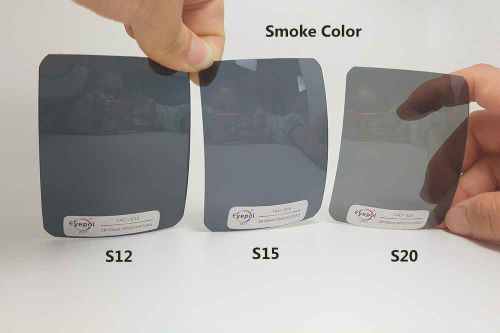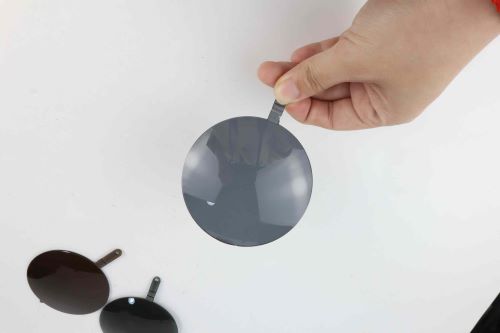TAC, PC, and Nylon: Picking the Right Lens Material for Your Line

Choosing the right lens material is one of the most critical decisions for any eyewear brand. It impacts everything from visual clarity and durability to cost and customer satisfaction. As an experienced OEM lens partner, we’re breaking down the pros and cons of three of the most popular sunglass lens materials: TAC, Polycarbonate (PC), and Nylon. Understanding their unique properties will help you align your product with your target audience and price point.
Material and ABBE Value/Clarity
Optical clarity is a key performance indicator for sunglass lenses, often measured by the ABBE value. A higher ABBE value means less chromatic aberration (color distortion), resulting in a clearer, more comfortable viewing experience.
- Nylon Lenses: With an ABBE value of around 50, Nylon lenses offer superior optical clarity, rivaling traditional glass lenses. This makes them a premium choice for high-end fashion and performance eyewear where crisp, accurate vision is paramount.
- TAC (Triacetate Cellulose) Lenses: TAC lenses provide good optical clarity, with an ABBE value typically in the low 40s. [2, 5] While not as high as Nylon, they offer a sharp visual experience with the added benefit of a polarized film, making them an excellent mid-tier choice.
- PC (Polycarbonate) Lenses: Polycarbonate has a lower ABBE value (around 30), meaning it can produce minor color fringing. While modern manufacturing has greatly improved PC’s optical performance, it is generally chosen for its other strengths over its sheer clarity. [4]

The choice of lens material directly impacts the wearer's visual experience.
Impact and Scratch Resistance
Durability is a major selling point. Consumers want sunglasses that can withstand daily wear and tear, and for active users, impact resistance is a crucial safety feature.
- PC (Polycarbonate) Lenses: This is where PC shines. It is virtually shatterproof and up to 10 times more impact-resistant than other plastic lenses, making it the industry standard for sports, safety, and children’s eyewear. [3, 4] It complies with the FDA's 21 CFR 801.410 impact resistance regulations. However, PC is a soft material and requires a hard scratch coating for durability.
- Nylon Lenses: Nylon offers a great balance of flexibility and impact resistance. [1] It’s more durable than TAC and suitable for active lifestyle and performance frames, especially those with a wraparound design.
- TAC Lenses: TAC lenses offer moderate impact resistance but can shatter under high force. [4] They are suitable for casual and fashion sunglasses but are not recommended for high-impact activities. [4] A scratch coating is essential to protect the polarized film.
Coating Combinations (AR/Hardening/Hydrophobic)
Lens coatings enhance performance, durability, and user comfort. The right combination can elevate even a basic lens into a premium product.
- Hardening (Scratch Coating): Essential for PC lenses to prevent scratching and highly recommended for TAC and Nylon to extend their lifespan.
- Anti-Reflective (AR) Coating: Reduces glare from light reflecting off the back of the lens, improving comfort and reducing eye strain. A valuable addition to any lens material.
- Hydrophobic/Oleophobic Coating: Repels water and oil, making the lenses easier to clean and keeping them clear in various conditions. This is a popular feature for sports and premium everyday sunglasses.
For a deeper dive into lens treatments, check out our Complete Guide to Lens Coatings.
VLT and Scene Matrix
Visible Light Transmission (VLT) refers to the amount of light that passes through the lens to the eye. The ANSI Z80.3 standard provides guidance on UV and transmittance levels. The ideal VLT depends on the intended use:
- Everyday & Fashion (VLT 15-25%): Standard grays, browns, and G15 greens work well across all materials for general use.
- Driving (VLT 10-30%): Polarized TAC is a great choice here, as the polarized film effectively cuts glare from the road. [2, 3] Brown and copper tints enhance contrast.
- Sports & Performance (VLT 10-20%): PC and Nylon are the preferred materials due to their impact resistance. Rose, amber, and brown lenses enhance depth perception and contrast, ideal for sports like cycling or trail running. Check out our sports sunglasses line for inspiration.
- Bright Conditions (VLT 5-15%): For snow, water, or high-altitude environments, dark tints and mirror coatings are effective at reducing intense light.
Recommended Pairings and Price Ranges
Here’s how these materials typically align with different market tiers:
- Entry-Level / Promotional: TAC lenses offer excellent value with the key benefit of polarization. Paired with a basic hard coating, they are perfect for trendy, affordable fashion lines.
- Mid-Tier / Lifestyle: PC lenses with a quality scratch coating provide a significant step up in durability. They are versatile enough for everyday wear and light sports, offering a great balance of performance and price. See our New Arrivals for the latest styles.
- Premium / Performance: Nylon lenses are the top choice for high-end applications. Their superior optical clarity, combined with hydrophobic and AR coatings, delivers an uncompromising visual experience for discerning customers.
Ready to Create Your Perfect Pair?
Understanding the nuances of TAC, PC, and Nylon lens materials empowers you to make smarter decisions for your eyewear line. At JINGS Eyewear, we specialize in OEM lenses and can help you select the ideal material and coating combination for your brand.
Contact Us Today






 Network Supported
Network Supported